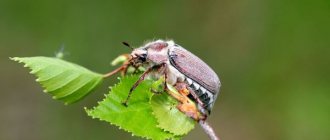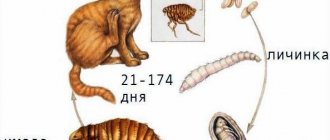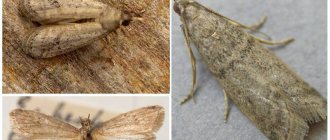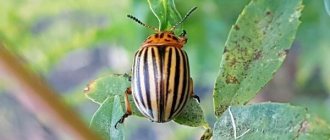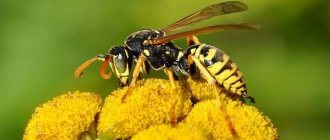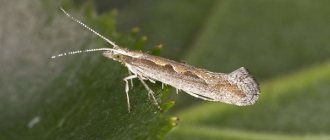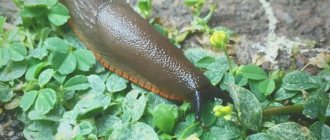Potato moth can destroy up to 80% of the crop. In the summer season, when insects eat the vegetative part of the plant, the activity of the pest is not limited. In autumn, the larvae infect tubers sent for storage, in each of which, if heavily infested, up to 10 individuals of different ages and sizes can be found.
Potato moth is a dangerous pest that damages potato tubers.
General information about potato moth
The scientific name of this insect is fluorimea. This pest is considered more dangerous than the Colorado potato beetle. Human economic activity has contributed to the spread of potato moth. It is considered heat-loving, so severe frosts prevent its reproduction in nature.
Geographical distribution
The historical homeland of fluorimea is certain areas of South and Central America, where plants belonging to the Solanaceae family are found in nature. For a long time it was found only in this region. Small outbreaks of potato infection with it were observed in Italy, Spain, Greece, as well as in Asian countries where seed material was imported from America. This is due to the climatic characteristics of these regions.
Only in the 80s. last century, the pest was first identified in the Crimea.
It is believed that the larvae were introduced along with tobacco and tomatoes. In the south of Russia, incl. in the Krasnodar region, the insect was discovered later. In addition, potato moth outside the boundaries of its natural range was identified in:
- China;
- Belarus;
- Ukraine;
- Kazakhstan;
- Australia;
- New Zealand;
- Kenya;
- Egypt;
- Iran;
- Tunisia;
- Algeria;
- Syria;
- Bolivia;
- Peru, etc.
Distribution area of the potato moth.
The slow spread of fluorimea is largely due to global warming. Now this insect can survive in regions where, until recently, severe winter frosts led to the death of adults and larvae remaining in the soil. The spread of the pest was also facilitated by improved storage conditions for tubers. The larvae are able to maintain vital activity if the temperature in the cellar does not drop below +10°C. They are often found on the walls of wooden boxes in the form of pupae.
Potato moth - control measures in the garden, in the cellar during storage
Potato moth (Phthorimaea operculella Zell) is a dangerous quarantine pest that can cause significant damage to nightshade crops such as potatoes, eggplants, tomatoes, tobacco, and peppers. The territories where the moth has settled are huge.
Today it lives in more than 70 countries around the world. And here in Kuban it was first noticed quite a long time ago - 1981. Why is potato moth dangerous for us gardeners? Something that can destroy all the potato stocks in the cellar.
Now, let's talk about what potato moth is and measures to combat it.
↑
Potato moth - development stages and lifestyle
The countries of Central and South America are the birthplace of the potato moth. How does she look? This is a very small, inconspicuous, nondescript butterfly. The wingspan is slightly more than a centimeter - only 12–16 mm. The front wings are gray, they have large dots and stripes, and the hind wings are plain with uneven terry edges.
Over the entire period of its existence, the moth goes through several stages of development - butterfly, egg, larva, pupa.
The entire development cycle takes 22–30 days in summer, and in winter the same process takes much longer – 2–4 months.
Moths are difficult to notice on potato bushes. This is not the Colorado potato beetle, which can be easily seen at any time of the day at various stages of development. The moth becomes active early in the morning, before sunrise, or late in the evening, after sunset.
But during the day, walk along the edge of a potato field and disturb the bushes. If the area is infected, then you will see how butterflies, very similar to ordinary clothes moths, take off over the plantings and, having flown 2-3 m, land on leaves, stems, ground, merge with the background, and immediately become invisible due to its small size.
The lifespan of the pest in the butterfly stage is approximately 3 weeks. During this time, she manages to lay 50–200 eggs on the leaves below, on the stems, potato tubers, and the fruits of other nightshade plants.
The moth larva, a caterpillar, matures in the egg in 5–15 days. This is the most dangerous stage of pest development from the point of view of gardeners, since it is the caterpillars that cause the greatest damage to potatoes, tomatoes, eggplants, and other vegetables, damaging tubers, fruits, stems, and leaves.
The larva (caterpillar) usually has a yellow-pink or slightly greenish color, the body length is from 1 to 1.3 cm. The lifespan of the caterpillar is 10–48 days, during which time it molts four times.
It enters the pupal stage on plants or soil, cracks in walls or floors, if it ends up in a storage facility or cellar.
The caterpillar or pupa spends the winter in the soil close to the surface or under abandoned plant debris. And in the spring, gray butterflies fly out of the overwintered pupae.
Potato moths of any stage of development can be found in the garden all season, from early spring to late autumn. And after storing, for example, infected tubers for storage, in the presence of favorable conditions, the development of the pest also continues in winter.
Moth caterpillars are particularly resilient. Potato tubers freeze and become unsuitable for food when the temperature drops to -1ºС, but the pest will survive in such conditions.
The best conditions for moths will be a temperature of +22–26°C with an air humidity of no more than 80%. If the air warms up above +36°C or cools below -4°C, then the insect will die, and it does not matter at what stage of its development it will be.
↑
External description of the insect
An adult butterfly has a nondescript appearance. The upper pair of wings is brownish-brown, and the lower pair is grayish. A large number of dark spots and streaks make the pest invisible. The edges of the wings are fringed with a fringe of fine hairs. The body is short and narrow, the insect has 3 pairs of limbs. There are long antennae on the head.
The oral apparatus of an adult is underdeveloped. The pupa has a dense, chitinous covering of brown color. The larva is white with a pale pink back and head. The adult caterpillar is covered with greenish-gray, stiff bristles.
Dimensions
The body of the butterfly is 7 mm in size, and the wingspan reaches 13 mm. The larvae grow up to 2 cm. The length of the pupa is about 1.5 cm, and the eggs are 0.8 mm.
Appearance of potato moth.
Features of development
The life activity of the pest depends on the temperature regime. On average, under favorable conditions, the development of a moth from egg to adult takes about 4 weeks.
Life cycle
The life cycle of the potato moth includes 4 stages: egg, larva, cocoon and butterfly. Females can lay eggs at +8…+25°C.
After mating, the female lives on average about 2-5 days. In rare cases, when she has difficulty finding a partner, the individual can live up to 2 weeks. Potato moths can multiply both in fields and in potato storage areas. At temperatures below -4°C, the pupae also die.
Controlling potato moth after harvest
The harvested potato crop is usually stored for long-term storage in order to use the tubers almost until the next season.
But if part of the crop is affected by this pest, then during storage the insects can crawl onto healthy tubers, as a result, most of the crop (about 4/5) will be destroyed, since potatoes damaged by potato moths cannot be used for food.
Before harvesting, you should treat the basement or other place where the potatoes will be stored with biological products.
The air temperature in such a room should be about 4 degrees Celsius
. At this temperature, the crop will not spoil and will not freeze. But the potato moth practically does not develop or reproduce in such conditions.
Air temperatures below 0 degrees Celsius are detrimental to this pest, however, potatoes also deteriorate in such conditions - they freeze and turn black.
Lifestyle
The life of the pest is associated with plants belonging to the Solanaceae family. Adult moths have a good sense of smell. She can even smell those tubers that were packed in canvas bags.
Adults cannot eat fully and live off the nutrients accumulated in the larval form.
At the same time, the insect is able to travel up to 3 km in search of plantings necessary for feeding the young.
What do potato moths eat?
Fluorimea feeds not only on potato tubers and tops. The diet of this pest includes the following crops:
- tomatoes;
- petunias;
- pepper;
- physalis;
- tobacco;
- eggplant.
In addition, some weeds may suffer from this insect, incl. Datura, black henbane and wolfberry.
Wintering of the pest
In warm regions, formed potato moth pupae overwinter under the remains of tops. In the northern regions, immediately after the tops dry out, the caterpillars move into the ground and infect the tubers. Subsequently, they pupate and remain in the soil at a depth of up to 20 cm. The emergence of adult individuals in this case occurs in May.
If the caterpillars are not yet fully formed, they remain in the tubers. They are dug up along with potatoes and stored in cellars. In larvae kept in a cool room, development proceeds more slowly. They reach adulthood only in spring.
Features of the life and development of the pest
Moth butterflies prefer to fly out in the late afternoon and rest throughout the hot day on the inside of the leaves. This is where they lay their eggs. The clutch consists of 1-2 eggs close to each other, light gray or white. As the larvae develop, they darken.
The caterpillar, which hatches 3-14 days after laying, forms spiderweb caves on the surface of leaves, fruits, vegetables and root vegetables from a specially produced sticky substance. Under their cover, it gnaws long winding passages under the cuticle of plants and the skin of tubers, going deeper as it grows and feeds.
Before turning into a pupa and then into a butterfly, the caterpillar goes through 4 stages of development, during which it feeds intensively and molts. The pupal stage takes one to two weeks. After emerging, the newborn butterfly is immediately capable of mating and laying eggs.
One butterfly is capable of laying up to 100 eggs during the breeding season; such high fertility allowed it to quickly spread across the European continent. The good adaptive abilities of this insect contributed a lot to this. It feels great in a fairly wide temperature range, from 8 to 35 0C. While all the other butterflies are still sleeping after a long winter, the potato moth has already made its first flight and laid eggs on the leaves of the plants.
The insect is able to reproduce year-round, provided there is a heated room, as a rule, this becomes a potato storage room. In the field, individual individuals can survive mild frosts, overwintering in the tubers remaining after harvesting.
Reproduction nuances
The female makes up to 4 clutches in summer. They contain on average up to 200 eggs. She tries to distribute them among a large number of plants. In this case, the offspring will have a sufficient amount of food, which will ensure rapid growth and development.
Eggs and larvae
The potato moth spends most of its life in the form of eggs and larvae. The optimal temperature for their development is +9…+28°C. The warmer it is, the faster the larvae hatch. In summer they appear on average after 5-7 days, and in winter - after 18-25 days.
The larva that emerges from the egg immediately begins to feed. Its growth is possible at +6…+25°C. Temperature affects the larval metabolism. In summer, it takes 10-20 days to accumulate nutrients, and in winter – up to 35 days. After this, the larva forms a cocoon. Metamorphosis from a larva to an adult takes 5-6 days in summer, and up to 90 days in winter.
Stages of development of potato moth.
Description and appearance
The potato moth is an inconspicuous flying insect whose wingspan reaches 12 mm and body length is 6-7 mm. Color grey-brown. There are many black spots on the wings. In the front part of the body there are elongated thin whiskers that help the potato butterfly easily navigate in space. The edges of the pest's wings are uneven, edged with light fringe.
Potato moth caterpillars have an elongated, segmented body and three pairs of dark legs, which are located in the thoracic region. When born, the larva has a pale body color and a black head, and its length is 2 mm. As the caterpillar develops, it grows up to 13 mm and, depending on its habitat, its shade changes. Larvae living on leaves become green, while those parasitizing on tubers turn light pink or off-white.
Appearance
Lifestyle and distribution area
The potato moth is nocturnal. Adults begin to fly in the spring with the arrival of stable warmth and continue until September.
South America is considered the birthplace of the insect. But at the beginning of the 20th century, the pest spread along with infected potato tubers to European countries, Africa, and New Zealand.
In Russia, moths are found in the Kuban and Rostov region, which is due to the thermophilic nature of the insect. After all, adult pests die at a temperature of -40C degrees, but the larvae are able to overwinter even in frozen tubers that remain in the field.
Life cycle
The insect development process consists of four stages: egg, larva, pupa, adult. At temperatures from + 27 to 350C it takes 3-4 weeks. When air temperatures drop, the life cycle can extend up to 6 months.
After mating, female potato moths lay up to 20 eggs at a time on the underside of the leaves of the plant. On days 5-7, small larvae emerge from them, which are particularly voracious. Subsequently, the caterpillars go through four molts and pupate. This stage of development takes 5-6 days. After this, butterflies emerge from the pupae and are capable of reproducing offspring.
The lifespan of potato moth is 10-14 days. During this time, she lays up to 200 eggs. During the season, the pest breeds up to 4 generations of offspring. The potato moth overwinters in the pupa or final instar caterpillar stage.
What does it eat?
Adult pests do not feed. They live off the nutrients accumulated in the larval stage. But potato moth caterpillars have a good appetite. When they are born, they begin to feed on the lower part of the leaf until the plate dries out. Subsequently, the caterpillars move onto the potato tubers and penetrate inside through the eyes, eating away the passages in it.
Potatoes located close to the soil surface are more damaged. And those that are located at a depth of 10 cm remain inaccessible to the pest.
Harm
Damage caused
Potato moth not only harms nightshade crops. It can also pose a danger to human health.
For potatoes
Insect larvae eat green potato tops. Flowers often suffer from them. Thus, the ovary does not form, which reduces the number of tubers forming in the ground. The larvae quickly eat up the tops. This leads to the fact that the process of photosynthesis is disrupted and the plant weakens.
Too few nutrients are produced to be stored in the roots. The tops dry out quickly, so the tubers remain small. After destroying the vegetative mass, the larvae move to the underground part of the plants.
Damage to potatoes by caterpillars also occurs after storing potatoes.
For man
Rooted roots become unfit for consumption. Infected potatoes cannot be stored or sold. Thus, the moth causes great material damage to farms that grow this crop. It is believed that accidental consumption of the larvae may be hazardous to human health. Toxic substances present in the tops of the plant accumulate in the body of insects. Ingestion of several larvae can cause poisoning.
Signs of potato moth infestation
When examining tops infected with the pest, damaged leaves and thin cobwebs are found that remain when the caterpillars move. There are loose spots on the surfaces of infected tubers. Inside you can identify black thin passages and living larvae.
Potato moth is placed on the underside of the crop leaf.
Insect control methods
If cases of potato pest infestation are detected in the territory, efforts must be directed to prevent the spread of the moth. Particular attention is paid to the preparation of seed material, as well as carrying out agrotechnical measures to prevent the spread of insects. To prevent infection, you can use biological and folk remedies. In case of severe potato moth infestation of the crop, it is advisable to treat it with chemical insecticides.
Before sowing
The seed material must be sorted out. Planting infected specimens is unacceptable. In areas where cases of pest damage to tubers have previously been detected, it is recommended to use seed imported from the northern regions. When planting, it is extremely important to maintain a distance of at least 75 cm between bushes. In this case, the tops of the plants will not touch, which will make it difficult for the larvae to move. Root crops should be planted to a depth of at least 15 cm.
During germination
To prevent moths from damaging the tops, bushes should be hilled up in a timely manner. Young shoots should be under a 5 cm layer of soil. Sprinkler irrigation is of great benefit. This leads to the death of a large number of adults. If signs of damage to the vegetative part of plants are detected before flowering, spraying with insecticides is recommended.
Regular hilling of potato bushes prevents the proliferation of potato moths.
It is worth harvesting immediately before the tops completely wither; immediately after harvesting, the potatoes must be removed from the field in a short time. It is advisable to immediately sort it out and destroy the damaged tubers.
It is advisable to burn the tops and infected root crops.
Protecting potatoes during storage
Damaged tubers.
Before storing the crop, it needs to be sorted. Remove all damaged tubers to prevent pests from spreading to healthy vegetables. The room also needs to be cleaned by fumigation or by washing with a solution of ferrous sulfate and lime.
You can also process the tubers themselves. To do this, prepare biological solutions into which the tubers are placed for a few minutes. Then they need to be dried well and can be sent for storage.
Chemicals
Chemical preparations are recommended to be used before and after potato flowering. The last treatment should be a month before harvest.
Organophosphorus preparations
Phosphorus-based insecticidal preparations are actively used to combat potato moths. They affect not only fluoromea, but also the Colorado potato beetle. This group of drugs includes:
- Zolon.
- Volaton.
- Fozalon.
- Foxim.
Such products are also dangerous for humans, so you must follow the dosages recommended by the manufacturer. Before carrying out work, you should wear personal protective equipment.
Pyrethroids
The active substance of this group of drugs is able to penetrate into the leaves, interacting with cell sap. Caterpillars consume poison when feeding, which leads to disruption of the nervous system of insects. The following drugs are classified as pyrethroids:
- Ambush.
- Tsimbusch.
- Decis.
- Arrivo.
- Alatar.
- Oradelt.
- Alatar.
Drugs from the pyrethroid group cause damage to the nervous system of moths.
Prevention
To protect plantings from the fluorimea pest, a number of preventive measures must be taken.
Among them:
- purchasing planting material only in proven places;
- germinate tubers;
- remove weeds and hill up plantings;
- carry out cleaning in a timely manner;
- process before planting and before storing.
Treatment with special preparations against Colorado potato beetles will also help against potato moths.
Agrotechnical means
Biological agents are less effective than chemical drugs. They are often used as a preventive measure to prevent damage to tops and tubers by insects.
Entobacterin
Entobacterin suppresses the activity of more than 49 species of pests. The preparation contains a number of beneficial microorganisms. In 1 mg of the product there are up to 30 billion spores. The drug is diluted with warm water in a ratio of 1:10. After this, the potato bushes are sprayed with the solution.
Bitoxibacillin
Bitoxibacillin is diluted in water at the rate of 100 ml per 10 liters. They spray potato tops in the evening. It is important that the air temperature is more than +20 °C. The drug begins to act immediately after the larva enters the digestive tract. She stops feeding and dies within 5 days.
Bitoxibacillin is one of the safest insecticides for controlling potato moth.
Dendrobacillin
Dendrobacillin is available in the form of a brown powder. To obtain a solution, you need to dilute 100 g of the substance in 10 liters of warm water. Potatoes should be processed 2 times with an interval of 7 days. After eating the treated tops, the larvae experience intestinal paralysis. They stop feeding and die.
Lepidocide
This drug contains microorganisms that can destroy fluorimea at all stages of its development. Protein toxins break down the intestinal walls of caterpillars. Pests die a few days after treatment, because can't eat.
Gas tablets
Gas tablets can be used in dry and warm weather. They are placed between the rows and lit. This ensures uniform fumigation of all bushes. Often these drugs are used to fumigate basements.
Do not inhale the gas released during combustion.
Traditional methods of getting rid of fluorimea
Folk remedies against fluorimea are less effective than chemical and biological ones, so they are recommended for use to prevent infection.
You can scare away adults with a decoction of celandine. To prepare the product, 1 kg of plant is crushed, poured into 5 liters of hot water and boiled for 10 minutes. After this, the composition is left to cool, filtered and diluted with another 5 liters of water. The product can be used to treat both tubers before planting and tops.
To combat potato moth, tubers are treated with infusion of celandine.
To prepare another folk composition you need 1 tbsp. mix wood ash with 1 tbsp. chopped wormwood and pour 3 liters of boiling water. The product is infused for 4 hours, then filtered and used to spray plants. Be sure to wet the bottom of the plant.
Prevention of occurrence
Prevention of potato damage includes the following measures:
- Limiting the import of seed from regions where cases of infection have been recorded.
- Regular inspection of green bushes to promptly identify signs of damage to plant leaves.
- Treatment of root crops with bacterial insecticidal preparations before planting.
- Cutting and burning the tops a few weeks before harvest.
- Destruction of tubers damaged by larvae.
Potato moth and how to fight it in the garden
The fight against fluorimea begins immediately after its detection. The sooner the plants are treated, the greater the chance of saving the crop. Chemicals are used to kill the insect. The drugs used to combat the Colorado potato beetle have a very good effect. In addition to them, biological insecticides or traps are used.
Chemical insecticides
The use of these drugs is very effective in controlling potato pests. They are able to quickly destroy adult potato moths and their larvae. But using them is dangerous. These products contain toxic ingredients. If handled carelessly, they can cause harm to health.
The following drugs from this group of substances are usually used:
- Decis;
- Prestige KS;
- Arrivo;
- Sherpa;
- Dunadin;
- Zolon.
The products are used according to the instructions immediately after detection of insects. In this case, the treatment can be repeated several times every 15 days. In early May, potato plantings are treated with “Prestige”. It destroys fluorimea larvae and Colorado potato beetles.
Important!
Treatment with chemicals greatly reduces the fertility and activity of females. Therefore, the pest population is declining.
Biological insecticides
Such products do not harm plants, health or the environment. Potato tubers also remain clean and edible. To destroy harmful insects, potato plantings are treated with the following preparations:
- Dendrobacillin is commercially available in powder form. Does not pose a danger to humans and animals.
- Lepidocide does not accumulate in plant tissues, is non-toxic, and emits an unpleasant odor that repels insects.
- Enterobacterin is used to treat potato fields during the flowering of bushes or harvest.
- Bitoxibacillin is suitable for repeated processing of potatoes every 10 days.
These preparations are suitable for spraying bushes throughout the summer. They can be used from the moment the sprouts germinate until harvesting. These substances destroy many larvae, and females are deprived of activity. The development of insects from exposure to substances is greatly slowed down.
Agrotechnical techniques and prevention
To prevent potato fields from becoming infected with fluorimea, only clean tubers are used for planting. It is recommended to plant early varieties first. They are not sensitive to attacks from this insect. During planting, tubers are laid to a depth of more than 15 cm.
As the bushes grow, they hill up several times, raking the soil high. It is necessary to pour a thick layer of soil over the young tubers so that insects cannot reach them. Be sure to clear the plantings of weeds. This procedure can be combined with hilling. The destruction of adult butterflies is facilitated by watering potato bushes using sprinkling.
Potatoes are dug up as soon as the tops begin to dry out. A week before digging, it is advisable to mow it completely. Cut greens must be burned. The harvest is harvested in a short time and immediately after that it is taken out of the field. After this, the potatoes are carefully sorted and all specimens damaged by the larvae are destroyed.
Quarantine measures
Quarantine measures include:
- Compliance with established rules for transporting tubers outside the phytosanitary zone.
- Examination of potatoes by a laboratory that issues certificates of the absence of pests in the samples.
In addition, there are a number of phytosanitary measures that are aimed at suppressing the source of pest infestation. These include:
- Use only healthy seed.
- Maintain a distance of at least 1 km between the place where root crops are stored and new sown areas.
- Destruction of tops before they are completely dry.
- Separate storage of tubers from different fields.
- Treatment of fields where moths were detected with insecticides.
Useful tips and advice for gardeners
Many gardeners note that the risk of infection is significantly reduced if a small amount of wood ash is poured into the hole when planting potatoes. In addition, avid gardeners believe that to prevent the spread of the pest, it is necessary to observe crop rotation, not allowing potatoes to be planted in places where other nightshades previously grew.
Olga Tsvetkova. A gardener with twenty years of experience.
Previous
MothUseful tips and recommendations on ways to destroy cabbage moths
